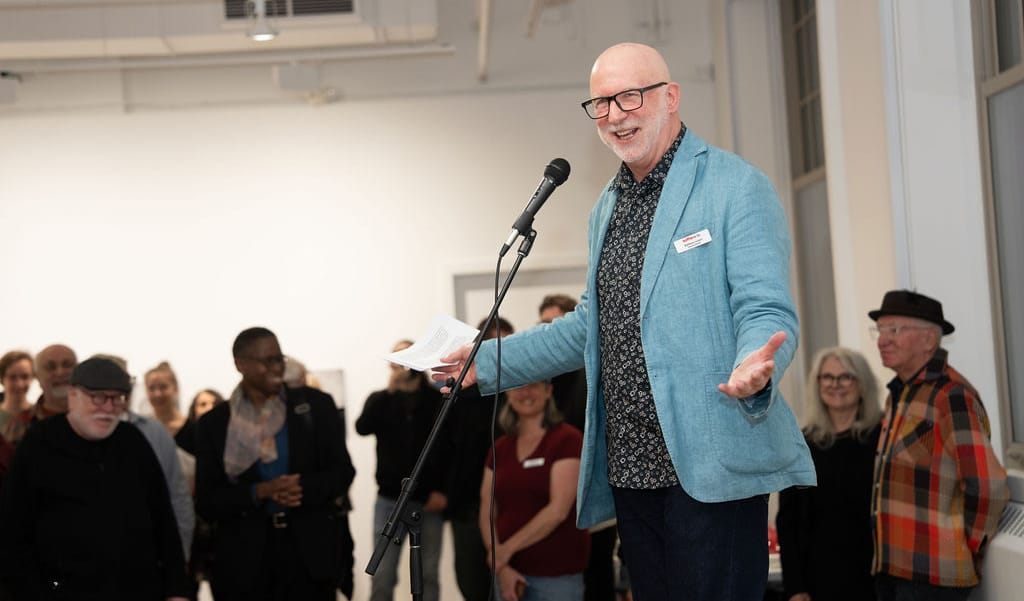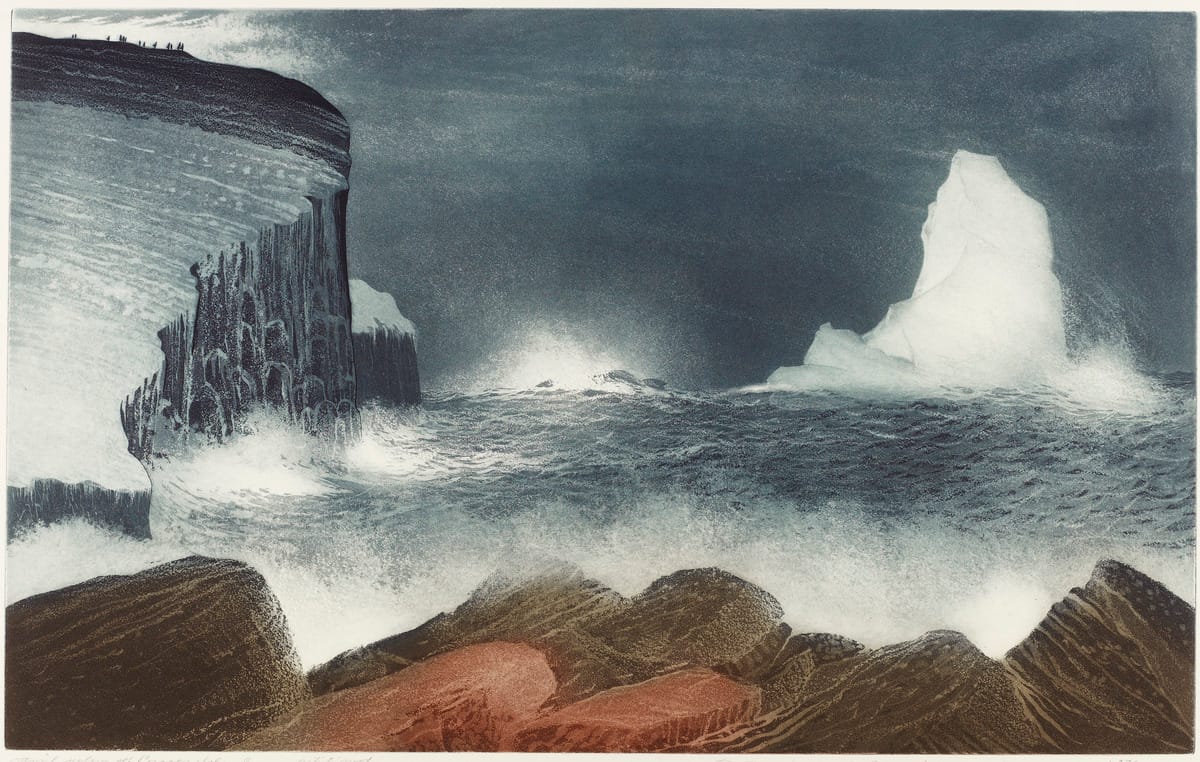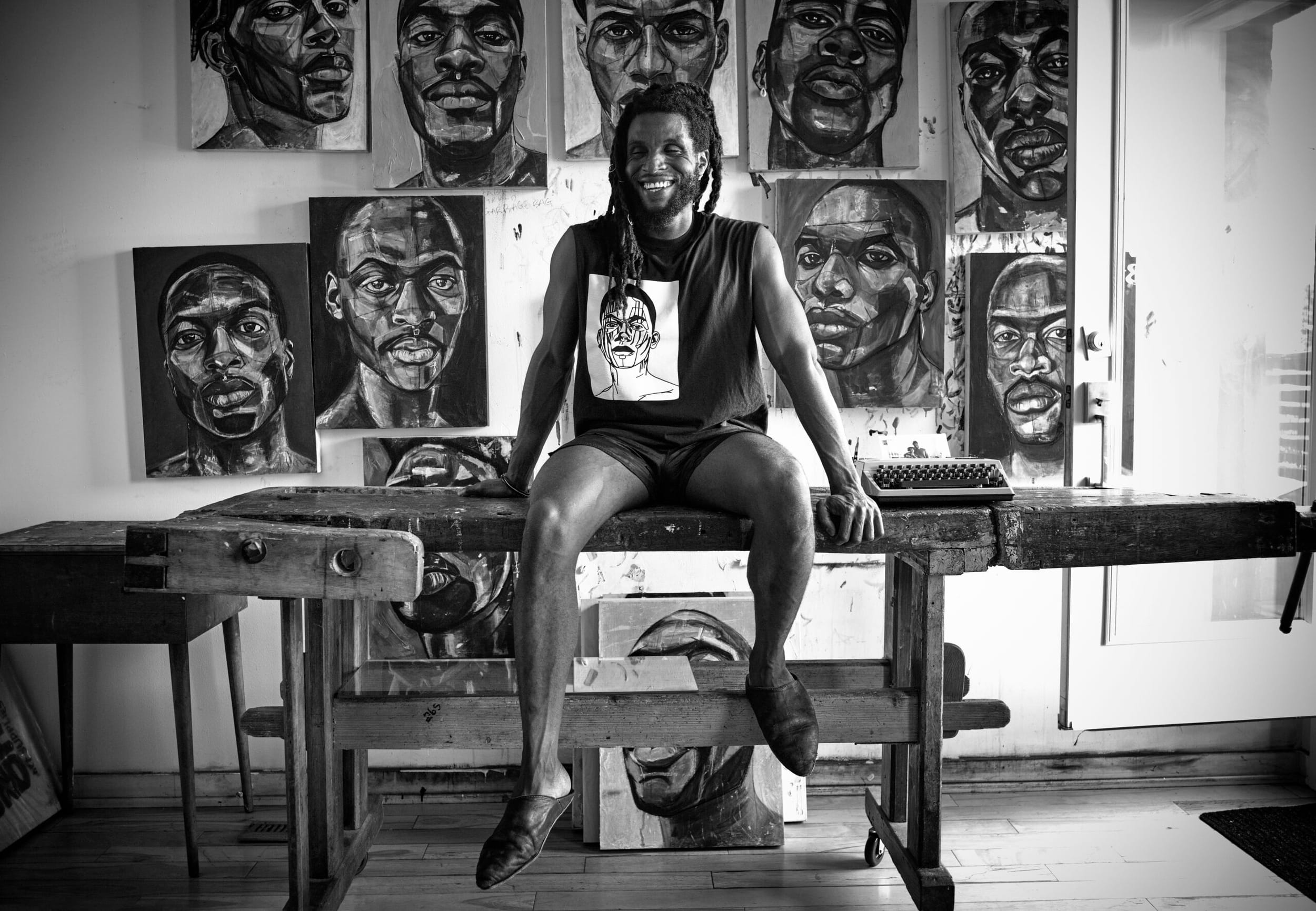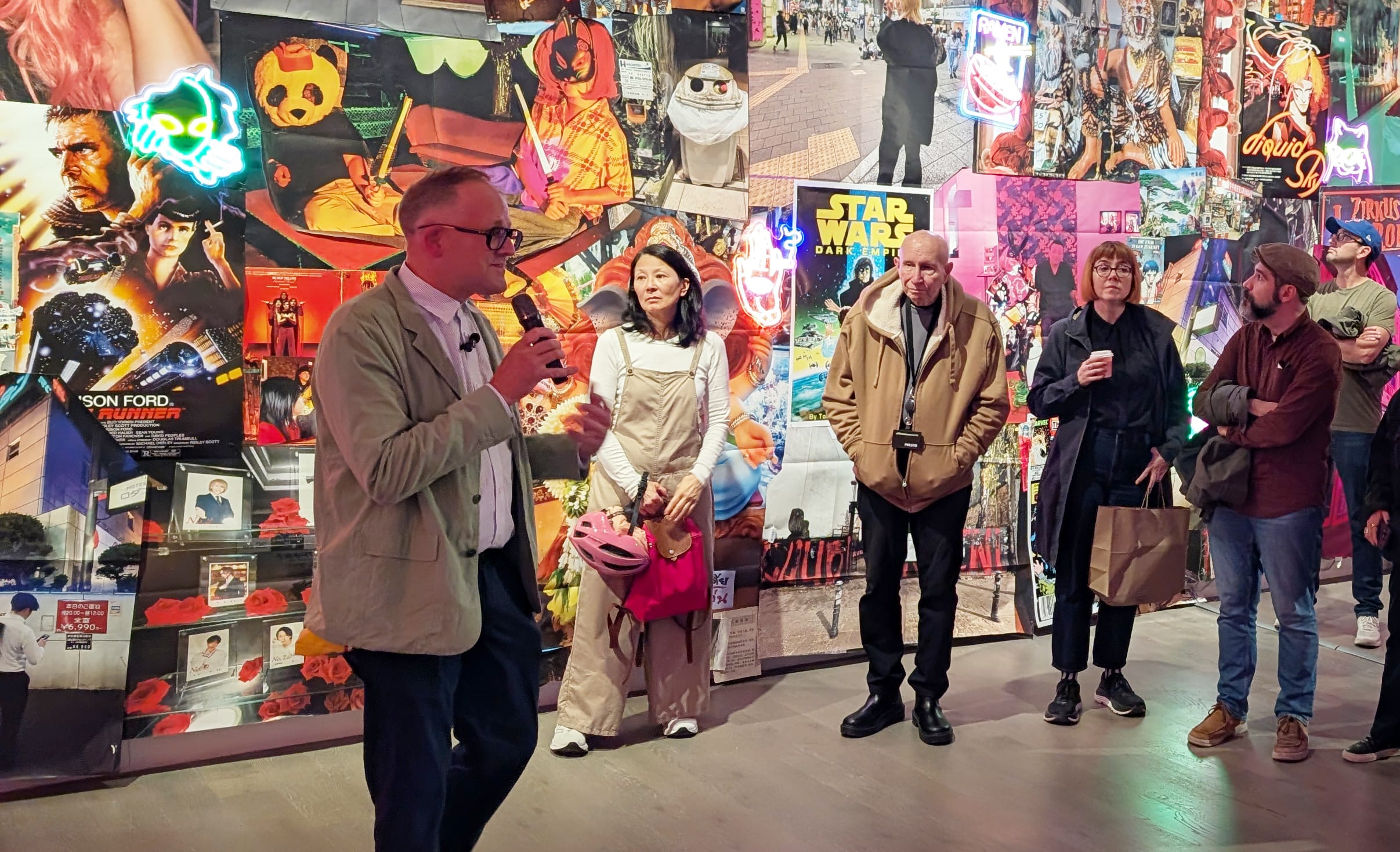Form is Always Full of Meaning
In conjunction with her career retrospective now at Koffler Arts, Elana Herzog speaks with curator and longtime friend Jessica Stockholder about 1970s New York, the misunderstandings of formalism, and the evolution of a practice decades in the making.
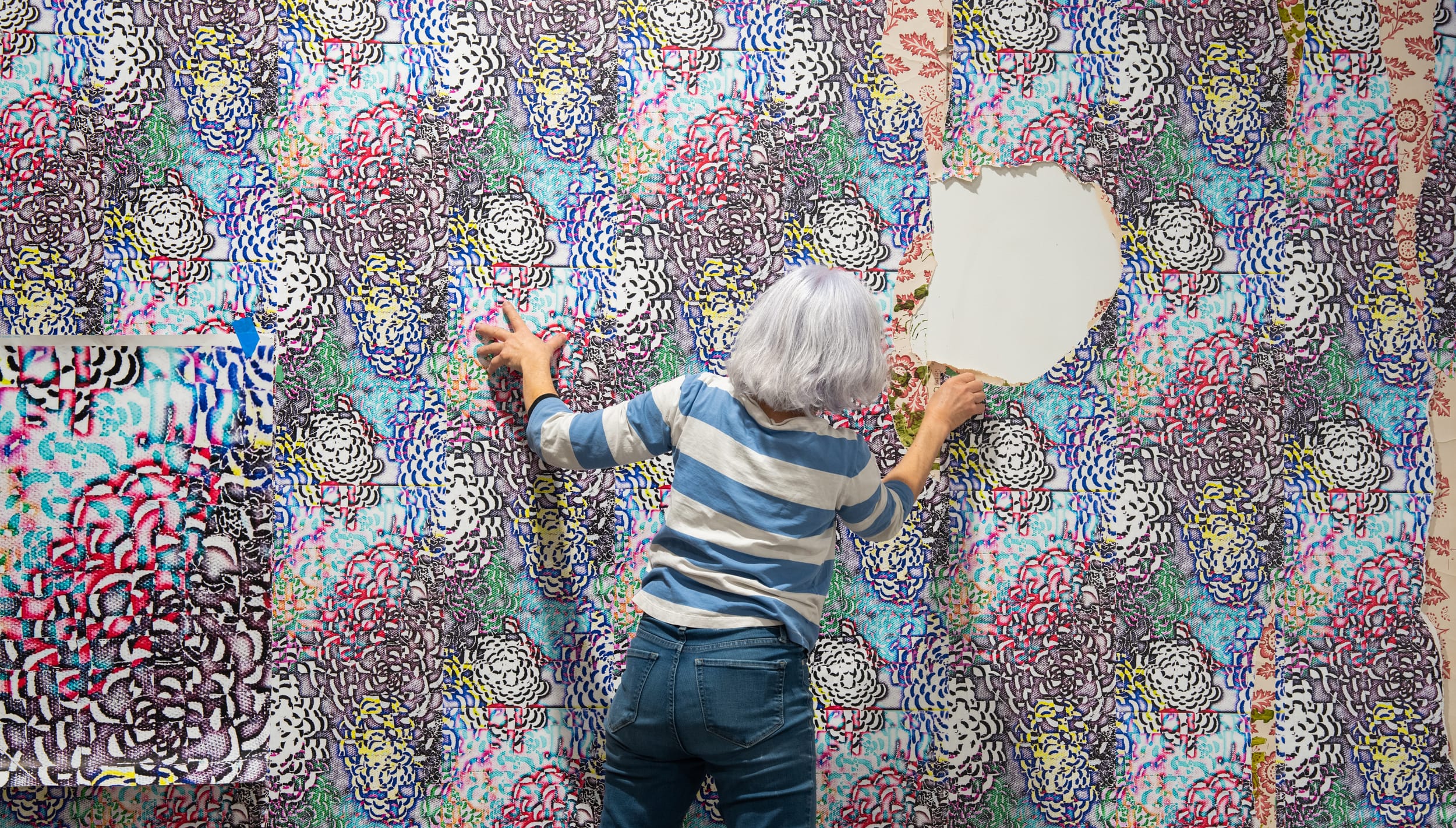
“... Coming out of school I was navigating this arena of, ‘Well, where do I fit into any of this? What does this have anything to do with me except as a sort of punitive system of judgment?’”
Best known for her abstract, sculptural assemblages made out of discarded textiles and other materials, Elana Herzog has never sat neatly within any of the prevailing categories, schools, or formal groupings of art discourse. Despite a rich lineage of post-war and contemporary artists incorporating textiles into their work—from Judy Chicago and Faith Ringgold to Nick Cave—Herzog’s practice has long stood apart since she started exhibiting in the 1990s, both in its formal concerns and conceptual approach.
Many artists working with textiles have typically engaged with the medium through its associations with personal narrative, domesticity, or craft traditions. Herzog approaches textiles less as carriers of narrative and more as cultural artifacts to be interrogated, dismantled, and physically deconstructed. Her signature process involves stapling, shredding, and embedding mass-produced fabrics into walls, panels, and architectural surfaces, subjecting materials often associated with softness and domesticity to violent gestures, resulting in works that feel both delicate and raw, fragile and aggressive, underscoring the material’s ephemerality and potential for transformation. A 2018 review in Artforum likened them to “intense visual stimulants.”
Meanwhile, Herzog has also tended more uniquely toward minimalism and the language of abstraction, though in ways that playfully subvert their conventions through the use of domestic and traditionally feminized materials like bedspreads, rugs, and upholstery. Her installations often leave behind ghostly traces of what was once whole—frayed fibers, torn patterns, grids of staples—transforming the familiar into something almost archaeological.
It’s as though the 70-year-old never stopped questioning where she fits “into any of this,” instead dedicating herself to her own intuitive methods of accumulation and subtraction, assembly and deconstruction. The text announcing Herzog as the recipient of a Guggenheim fellowship in 2017, described her practice as using “material culture to consider aspects of ephemerality and entropy, pleasure and pain, attraction and repulsion. She has built a visual language that is both formal and evocative, and is increasingly focused on the relationship between technology and culture, the hand and the mind, the mind and the machine.”
Or, as Herzog herself put it to the Toronto Star in a recent article, “I use a lot of textiles and other domestic and building materials to make work that is raw, visceral, intimate and tactile.”
Herzog’s work is now the subject of a career-spanning retrospective running until May 10 at Koffler Arts, which also features a new site-responsive wallpaper-based work. In an accompanying video created for the exhibition, Herzog speaks about the origins and evolution of her practice with artist Jessica Stockholder, the retrospective’s curator and a longtime friend. (The Squared Circle: Ringing, a new commission created by Stockholder, is now showing at MOCA in Toronto.) The following is an edited transcript of their conversation.
JESSICA STOCKHOLDER: Having known you from back when we both lived in New York, when I think about your work and its relationship to context I see it as very concerned with the particularities of where it is. That’s true also of all the work you’ve done in various countries where you’ve been invited to exhibit. My sense, from casual conversations we’ve had, is that you've done a lot of research about particular things about all those places in terms of textiles. You’ve also collected textiles from different places you’ve been. I wonder how you were thinking about that relationship to context at the outset.
ELANA HERZOG: First off, I would say that the New York we met in was a very different New York than we have now. It reminds me of the movie Taxi Driver, if you want to locate the period, a more gritty ’70s New York. That’s very much the New York I grew up in. And I feel like the aura of it, the gestalt of it, is very much a part of my biography. New York back then was dangerous at times, but I think it really had an impact on how we experienced our daily lives. And that tawdryness is something that I tried to inflect a lot of my earlier work with, as a way to contend with my ambivalence about beauty as a linchpin for what artmaking was.
Over the years I’ve become much more interested in research, specifically in regards to textiles, as a way of understanding culture, and relationships between cultures, and the way that traditions, motifs, and technologies migrate from one place to another. But in the days when we were getting to know each other I was a lot more interested in psychology and the emotional references that things had. I was remembering how we were all interested in psychoanalysis and used to attend Lacan seminars, for instance, as part of our efforts to educate ourselves or participate in a conversation.
STOCKHOLDER: Lacan and beauty were both topics of much writing and conversation at that time. It’s interesting, I’ve recently been thinking about beauty as a kind of managing of human pleasure and pain and distress, like when you go to a movie that’s about horrible things, but you leave and say, “Oh, it was such a beautiful movie.” I think it’s because beauty and aesthetics are a way of managing the distress of being human, which is always part of being alive.
HERZOG: Yes, beauty was controversial in some ways. I’d been educated in a kind of high modernist tradition, where abstraction and formalism were de rigueur; they were the language that I was taught. While doing ceramics in grad school, I started teaching myself about sculpture, in whatever way I could, somewhat by reading. So I was introduced to ideas around minimalism and modernism in sculpture in a way that I never had been before.
When I got out of school, I was confronted with the challenges that were coming from a postmodern theoretical place and also from an ideological place. And the whole idea of abstraction and modernism was castigated as, you know, bourgeois and decorative and meaningless, contentless and irrelevant.
And so coming out of school I was navigating this arena of, “Well, where do I fit into any of this?” What does this have anything to do with me except as a sort of punitive system of judgment, and how do I differentiate myself from my parents’ generation, and from all these voices that were judging and telling me what to do or not to do?
The way I dealt with that, in some ways, was to look for the abject, and for materials that were not associated with anything that I had done previously, a way to understand objects as being capable of having both beauty and ugliness within them, attraction and repulsion, and content but also formal characteristics.
I think that you as an artist were really a champion of that and introduced me to it in a way that no other precedents really had. There’s such a huge difference between being side by side with an artist who's a friend, and being exposed to art that's presented institutionally.
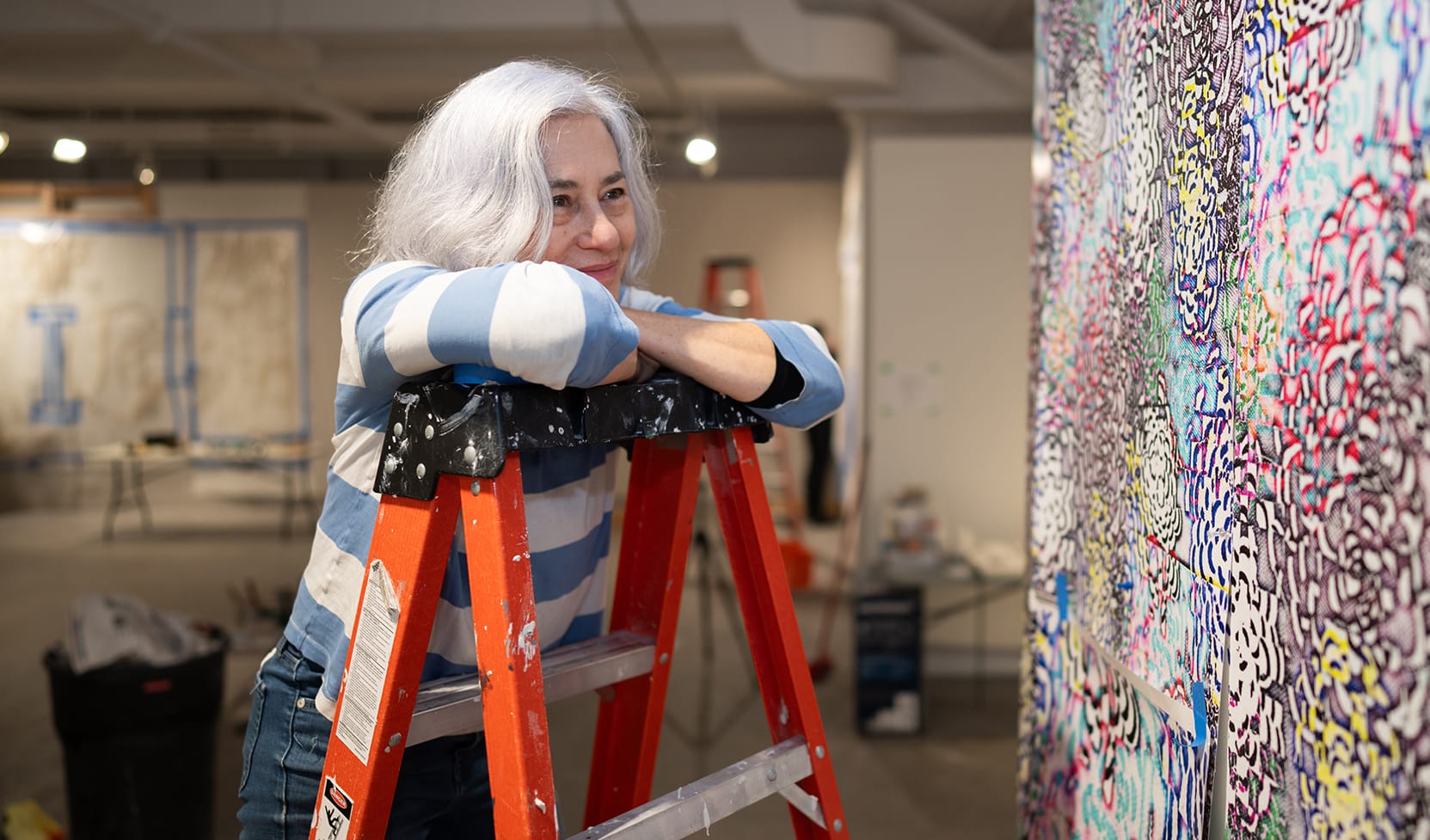
STOCKHOLDER: I remember being in your studio, early on when we first met, when you were still trying to figure out what you wanted to do, and your work was reflecting exactly what you just spoke about—asking questions about material and what you wanted to do with it.
I’ve never really liked the word formalism. I don’t distinguish between things being meaningful and form. Form is always full of meaning. How we organize ourselves formally around a dinner table, for example, is very equivalent to how we organize material formally. There are always economic and social expectations embedded in formal choices. So form is always full of meaning. Sometimes formal work can be boring, because nothing’s happening, or there are no questions being asked inside of that form. But narrative work can also be boring. I see both narrative and form as full of meaning
When I met you, you were also working as an electrician, working with your hands. There’s extraordinary intelligence built into all of the work people do with their hands, and there’s a social hierarchy that places manual labor on a lower rung than intellectual labour. Some of your works have involved a lot of labour—some of the works in this show, too, with the many, many staples and the time it takes to disintegrate the fabric.
HERZOG: Labour and repetitive labor can also be symptomatic, or an expression of a kind of madness.
Going back to our history of participating in theoretical arenas, it always felt vicarious to me, in the sense that I never became fluent in that language. I think that was part of its appeal and fascination at that moment. Still, I go into a swoon in a bookstore, but I never can get through a book. So it’s all about this potential, and this mystery of ideas, this mystification of ideas. Whereas the physical world was something that I was able to turn to as a real reaction to my family, who were all talkers and thinkers; I could excel on my own terms without anybody from that world being able to really say anything about it. I’ve always joked that my dad didn't know which end of the hammer to hold.
You said something earlier about form and its relation to content. That form has content. I would also say that content has form. It takes form, no matter how narrative, how conceptual, how decorative, all visual art by necessity takes form. And so those two things contribute to a perception of, or a belief that, form is imperative.
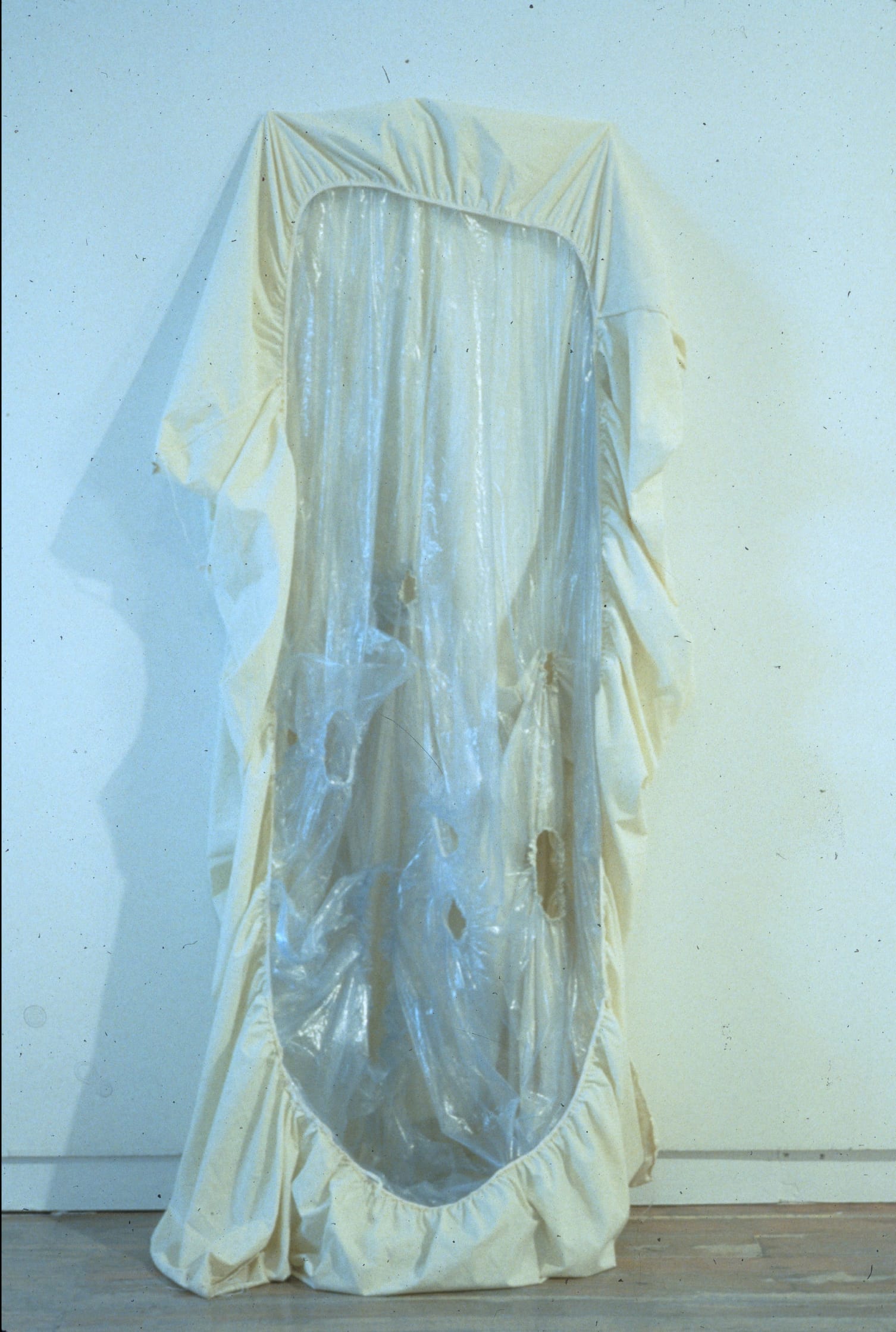
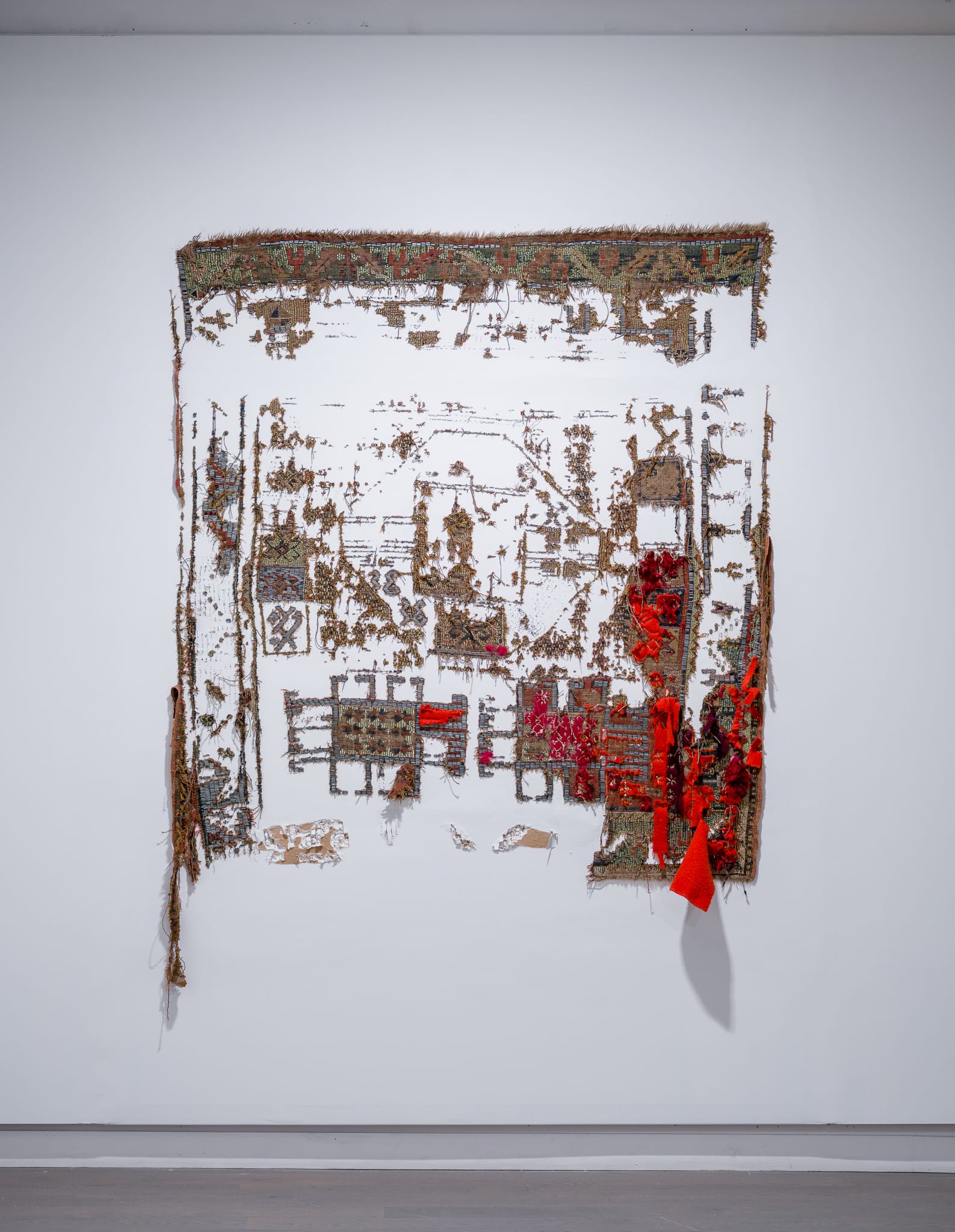
Left: Untitled #2, 1995 by Elana Herzog. Right: Untitled 2024, also by Herzog.
Untitled #2, 1995 is a fitted sheet that I inserted plastic into. The fitted sheet has always held a big fascination for me because it’s not a shape or a form that we really have a name for. It’s not a rectangle, it’s not a circle. It’s very hard to fold. It’s not even easy to get onto a bed. But it has a function that we recognize.
You can kind of see that the work in this period of the 90s gravitates between what I see as the extremes of the decorative and the kind of raw, stark, and abject. You can see here how it starts to evolve in the direction of the work that’s coming, which is the stapled work.
STOCKHOLDER: I'm looking at another of your pieces, Untitled, 2004—I believe you put this onto a piece of sheetrock that you then move around in the world. And when you install it, you kind of cut it into a sheetrock wall so that it doesn’t appear to be something that's moved around in the world. So some works, like this one, moves through time, and others are much less replicable.
HERZOG: Yes, this one is fixed in that sense, but also, in some ways, illusionistic, or a sleight of hand, because it is made to look like it was spontaneously created in that location. It looks as if its lifespan is just the lifespan of the exhibition, when in fact it’s not. So there are games being played there. This piece is in the Koffler show but it has also been exhibited several other times.
Another thing I’ve enjoyed has been playing with the painting references; the painting language having to do with figure and ground, and picture plane that this particular work gives me access to. If you think of the wall and the boundaries of the piece as being ambiguous, meaning that you don’t really know where the piece begins and ends, it can enter into a conversation with the idea that the wall is part of the work.
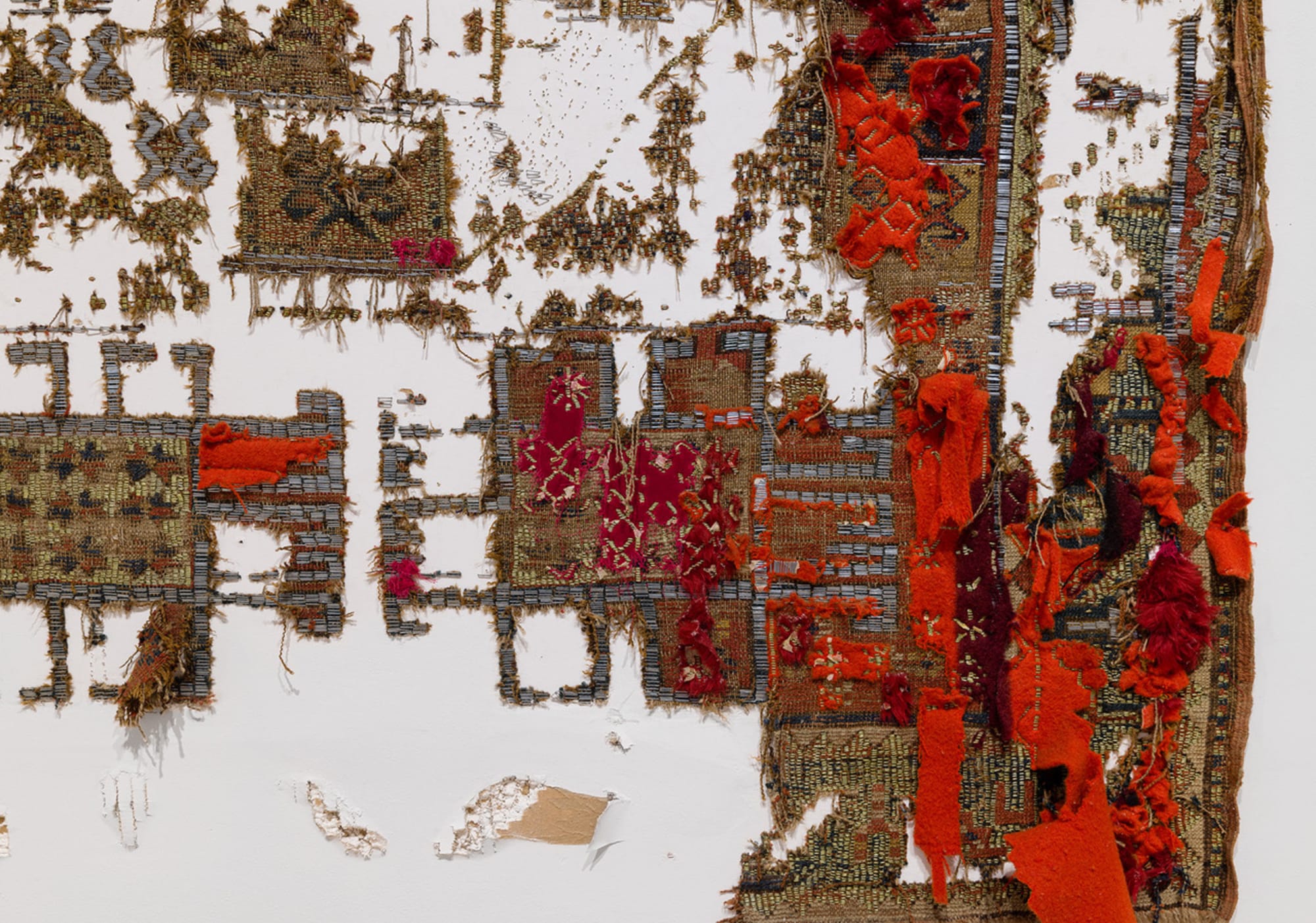
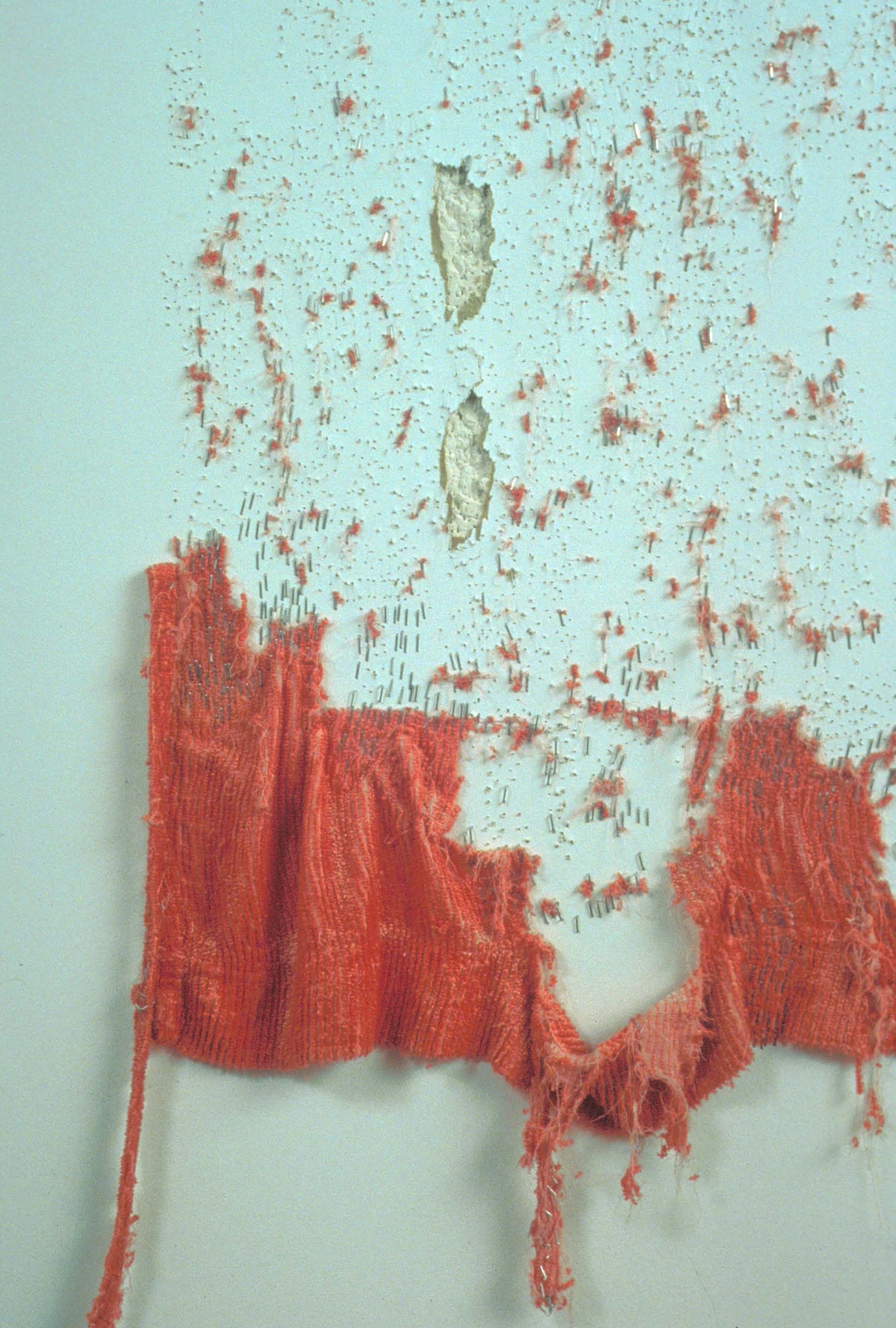
Left: Detail from Untitled 2024 by Herzog. Right: Detail from Untitled 1999, constructed out of a chenille drape.
Untitled 1999 was based on the idea of taking a chenille drape that somebody had given me and stapling along the lines of the pattern in the drape, and then pulling away the fabric and seeing what was left. When I first imagined it, I thought it would be very spontaneous and effortless, to just take this old fabric and rip it off the wall after I’d stapled it. But I found out that it wasn’t. It’s a very laborious process. It didn't happen the way I thought it would. It became a strategy where I was appropriating the composition directly from whatever pattern was in the textile I was using, and then stapling along this pattern and tearing away the surface to whatever extent I wanted to.
STOCKHOLDER: Inside of your work, you really care about your interaction with the materials, the evidence of your hand, in the same way as when you make a mark with a paintbrush it’s evidence of the movement of the body. It’s a little bit indexical, capturing the time you spent with it.
So there’s a very handmade quality to your work, but at the same time you’re reliant on many other people in different places, like the people who made these fabrics, sometimes it’s people and their hands in a direct way, and sometimes it’s machines and mass production. The sheetrock, for example, has been mass produced. I mean, where do all these materials come from? All of these materials come from the earth and have been manipulated. So you’re dependent on this shared flow of material, but your personal intersection with them is idiosyncratic and asserts the value of subjectivity that is part of human experience.
HERZOG: I want to say one thing before I talk about the sourcing. I feel like my work walks a precarious line between something that I’m happy with, and ruin porn. I’m not sure exactly how to express this… I feel like nostalgia is an impacting force in my relationship to materials, and my relationship to the past, and how I perceive the past in materials and in objects. And when I say nostalgia, I mean it as a fascination with or longing for something that doesn’t really exist. But I think it’s something to be cautious about—I don't want to be that person who's grinding away at jeans so that they look old. I want my work to be something else.
Over the years I’ve sourced materials in very different ways. Early on, most of my materials came from thrift stores and yard sales in upstate New York. I was trying not to spend a lot of money on materials for my work, so that was a good place to do it. I was always really intrigued by what I would loosely call Americana, which is what I would find in thrift stores. Chenille bedspreads in particular, because they represented a culture that I didn’t feel a part of. My parents didn't like that kind of thing, they were very attached to what they considered to be a more sophisticated aesthetic.
I know that chenille bedspreads are actually highly coveted by many Americans, but I was not brought up to like them, so my attraction to them was vicarious. It was part of somebody else’s culture that I was not a part of. People have often asked me whether there was anything autobiographical in my use of those materials, and it’s interesting to always say no, that my attraction was really a vicarious one. It’s possible that my attraction and interest in global fabrics has some of that as well—a desire to somehow penetrate or be part of or gain entry to the lives of others.


